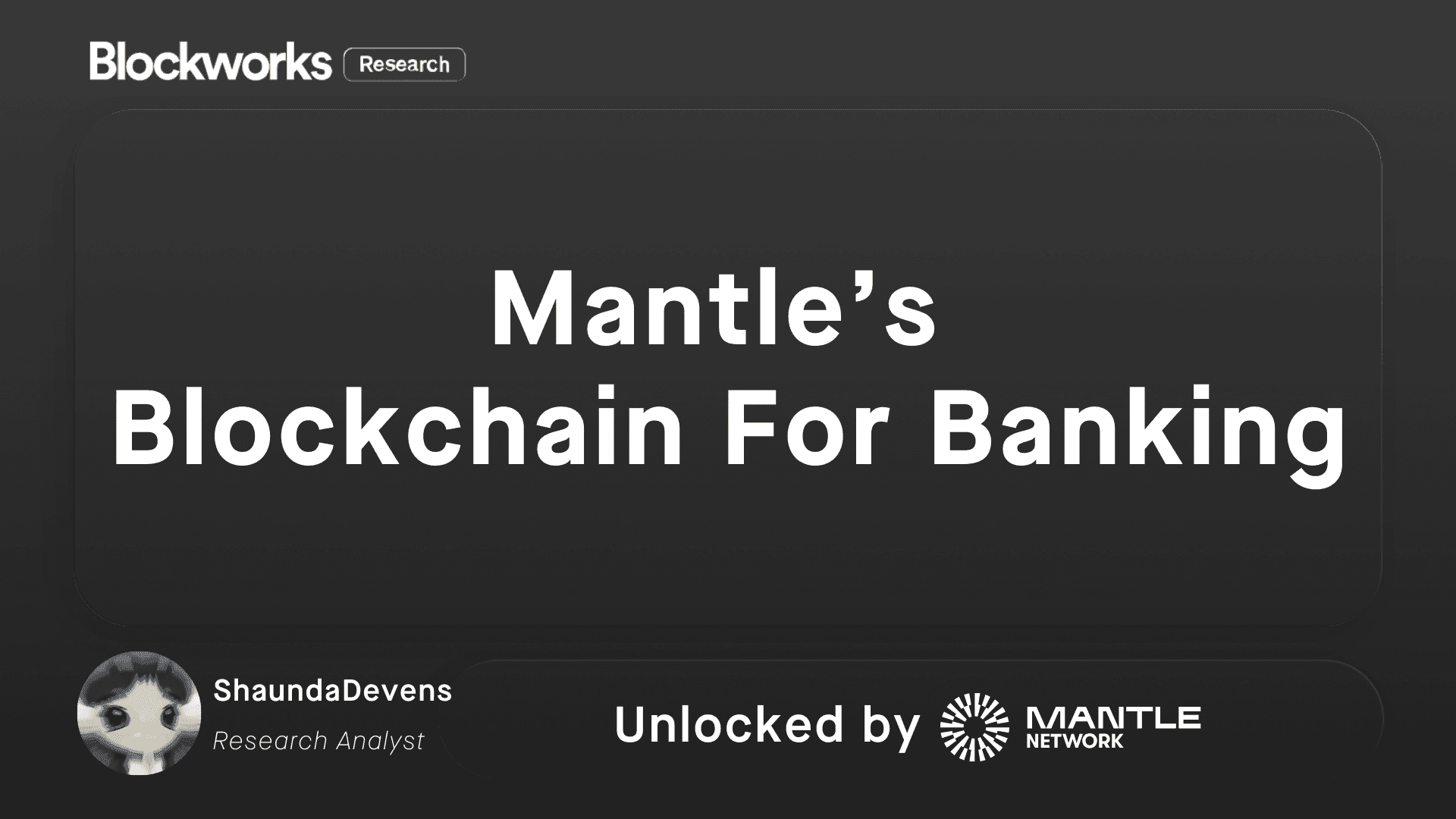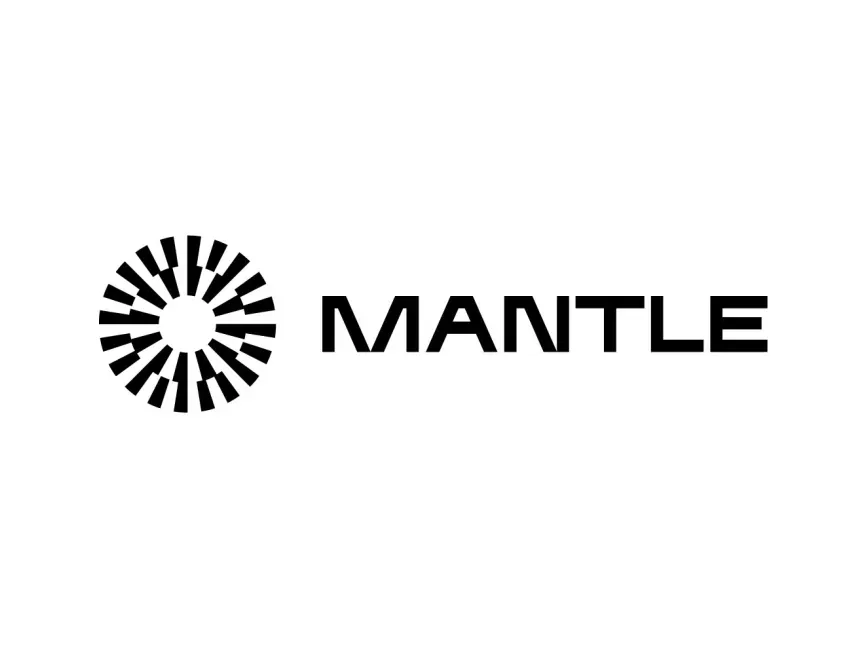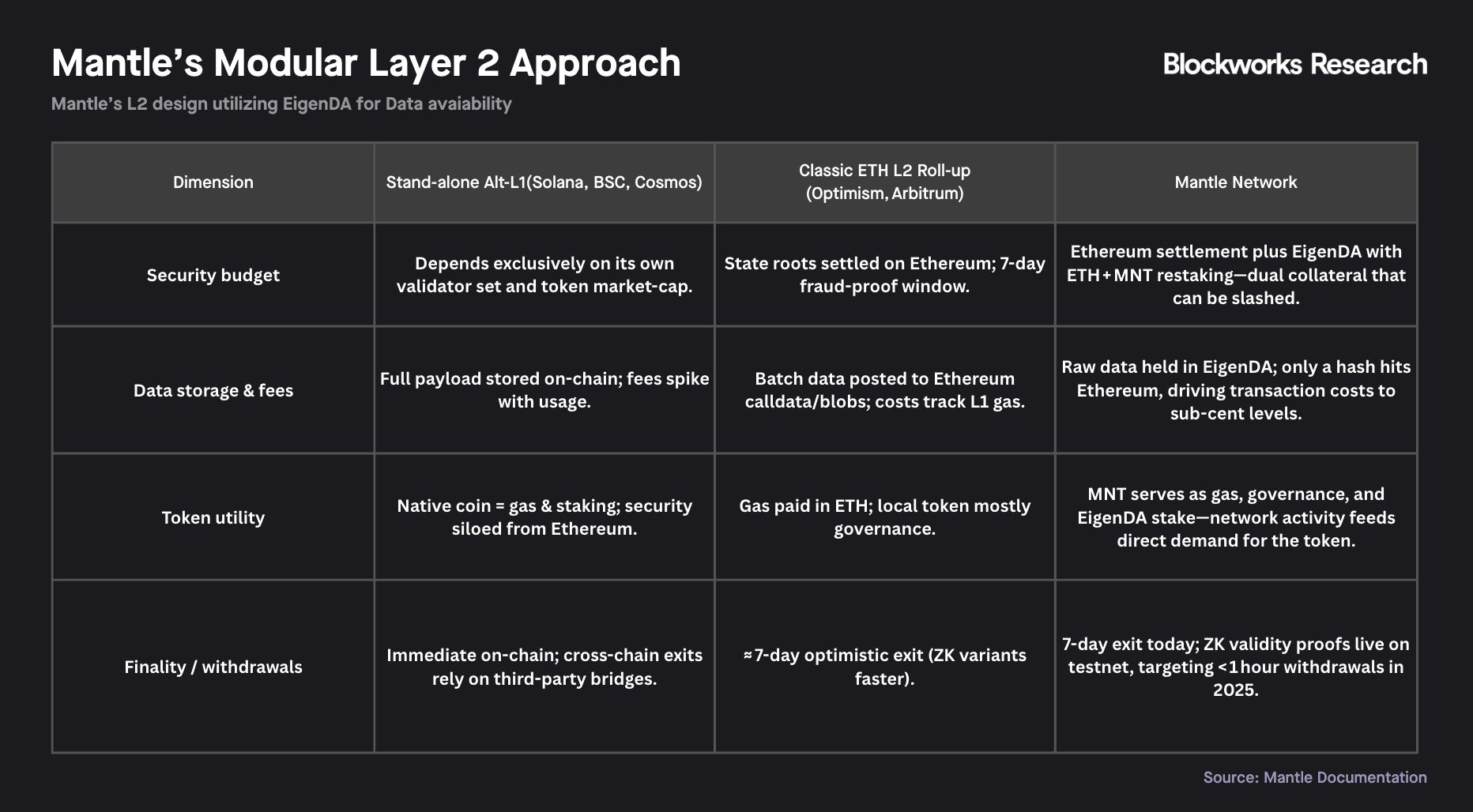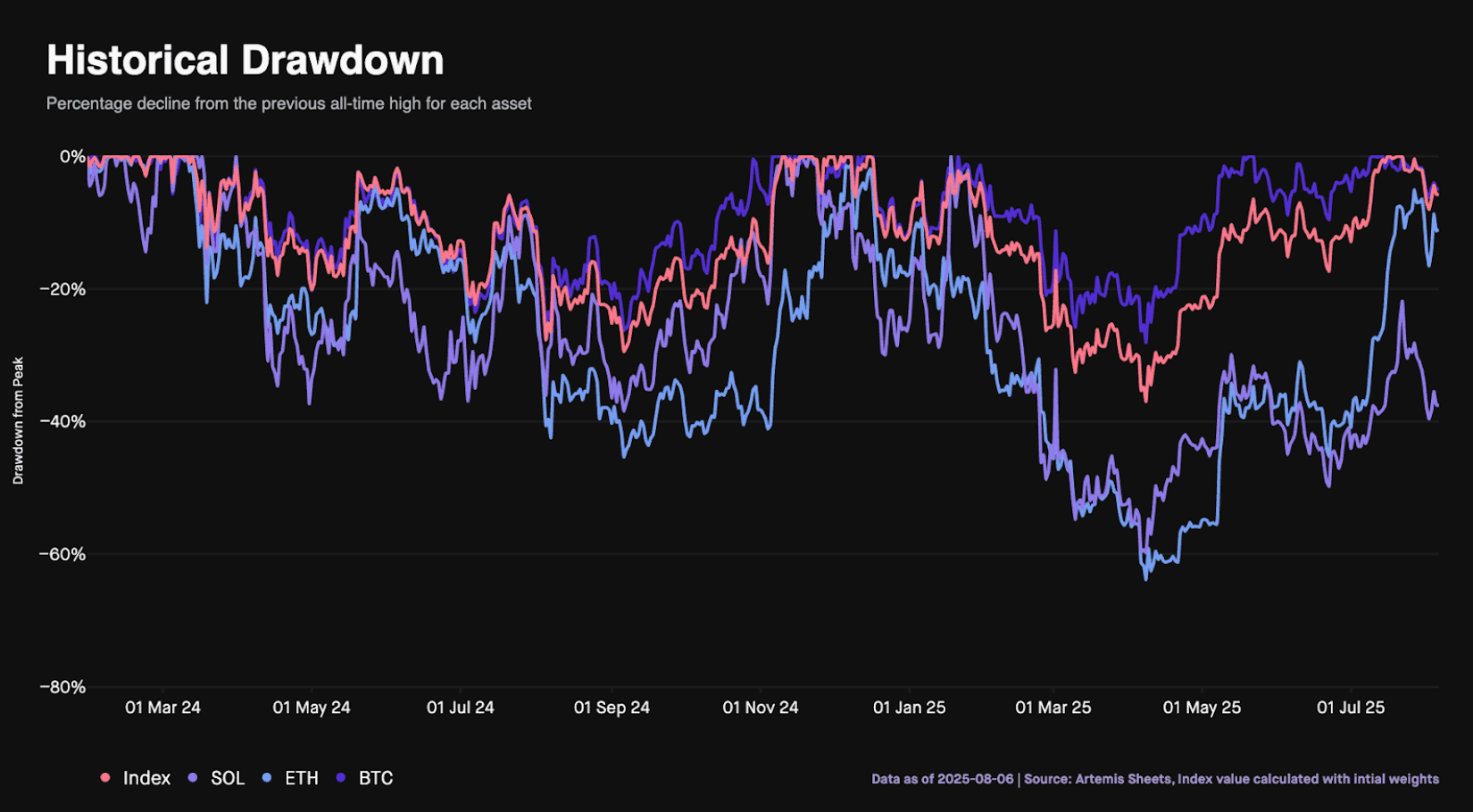This research report has been funded by Mantle. By providing this disclosure, we aim to ensure that the research reported in this document is conducted with objectivity and transparency. Blockworks Research makes the following disclosures: 1) Research Funding: The research reported in this document has been funded by Mantle. The sponsor may have input on the content of the report, but Blockworks Research maintains editorial control over the final report to retain data accuracy and objectivity. All published reports by Blockworks Research are reviewed by internal independent parties to prevent bias. 2) Researchers submit financial conflict of interest (FCOI) disclosures on a monthly basis that are reviewed by appropriate internal parties. Readers are advised to conduct their own independent research and seek advice of qualified financial advisor before making investment decisions.
Mantle's Blockchain For Banking
Key Takeaways
-
Mantle is a vertically integrated system designed to bridge traditional and decentralized finance, combining core infrastructure, consumer apps, institutional funds, and yield products into one cohesive ecosystem.
-
Mantle Network anchors the stack as a modular Ethereum L2 with EigenDA and OP-Stack upgrades, ensuring scalability, security, and sustained demand for the MNT token.
-
UR functions as the consumer gateway, merging fiat and crypto through tokenized deposits, Mastercards, and cross-border payments, initially targeting Asian non-dollarized markets.
-
MI4, mETH, and FBTC form Mantle’s institutional and yield pillars: MI4 provides diversified index exposure, while mETH and FBTC embed Ethereum and Bitcoin yields directly into the ecosystem, reinforcing Mantle’s role as a “Blockchain for Banking.”
Introduction
Mantle is a vertically integrated blockchain ecosystem purpose-built to bridge traditional finance and decentralized finance, forming the backbone of an emerging "Blockchain for Banking." Anchored by Mantle Network, a modular L2 solution seeded by Bybit, Mantle strategically integrates specialized verticals, including UR (smart-money application), MI4 (institutional crypto index fund), mETH Protocol (Ethereum liquid staking), Function (yield-bearing Bitcoin via FBTC), and MantleX (AI-driven innovation arm), to create a diverse ecosystem built on a performant network.
With the launch of UR, Mantle introduces a fully onchain money app that streamlines crypto adoption through a familiar fiat-to-crypto experience. Institutional-grade products such as MI4 and strategic investments like ReserveOne extend this bridge into broader financial markets. At the core of the ecosystem, the MNT token embeds value across all verticals, positioning Mantle as a foundational platform for the next generation of financial services.
Mantle Network
Mantle Network emerged as a modular L2 solution rather than a standalone L1, addressing key limitations faced by existing scaling models. Ethereum L2s historically relied on ETH for gas, which limited demand for their native tokens, while sidechains were forced to compromise between transaction speed and security. Mantle Network’s modular architecture, centered on EigenDA (external Data Availability), was designed to overcome these issues, enhancing scalability and security while acting as the foundational infrastructure layer for all future Mantle applications.
A central design feature of Mantle Network is its bespoke execution logic, which allows the native token, MNT, to function directly as the gas token, thereby embedding token utility through blockspace demand. In its early phase, Mantle relied on MantleDA, a custom EigenDA-based solution required pre-EIP-4844, supported by an external restaking network collateralized with ETH and MNT deposits. At the settlement layer, Mantle adopted an optimistic rollup model, publishing every state root to Ethereum L1 and securing them with a seven-day dispute window, thereby inheriting Ethereum’s robust security guarantees.
By Q1 2025, Mantle’s infrastructure had advanced considerably, with full integration into EigenDA marking a major step forward. This transition from MantleDA delivered a 20x improvement in censorship resistance (expanding from 10 to 200 operators) and a 234x increase in bandwidth capacity (15 MB/s vs Ethereum’s 0.0625 MB/s). Building on these improvements, Mantle introduced Mantle v2 (“Tectonic”), upgrading the execution layer to Optimism’s OP-Stack Bedrock. This change enabled full EVM equivalence, introduced stable 2-second block times, and established an EIP-1559 fee market with gas fee burns to stabilize costs. With EigenDA reducing overhead expenses, Mantle’s L2 economics have consistently been profitable, generating steady weekly revenues from transaction fees.
Looking ahead, Mantle successfully deployed OP Succinct on its Sepolia testnet, marking the first stage of its transition from a traditional Optimistic Rollup toward a ZK Validity Rollup. Once deployed on mainnet (expected Q3/Q4), this transition is designed to reduce settlement finality drastically, from over seven days to under one hour. Today, Mantle Network is positioned as a highly performant, low-cost Ethereum-secured L2 that uniquely sustains strong demand for its native MNT token. This is consistent with the modular architecture approach where upgrades and enhancements are iteratively made to improve performance and efficiency.
With $232M in TVL across ecosystem applications and over $1.6B of total value secured, Mantle Network provides the infrastructure and liquidity backbone for all products built within the Mantle stack.
UR
UR, built on Mantle Network, is a borderless smart-money application purpose-built to integrate traditional finance directly onto blockchain rails. Rather than competing within existing crypto sectors, Mantle leverages UR as the consumer-facing entry point to capture significantly larger traditional finance markets, which vastly overshadow current crypto segments. For context, traditional finance lending and credit markets stand at $11.3T loans outstanding, nearly 100 times crypto’s $117B equivalent.
Mantle’s strategic rationale is clear: TradFi faces operational challenges, creating substantial demand for secure, regulated, blockchain-native alternatives. Consumer trends reinforce this thesis. A recent four-country study (US, UK, Singapore, Saudi Arabia) found that *42% of consumers prefer digital wallets *over traditional banks or services like Western Union for cross-border transfers. Furthermore, a 2025 U.S. sentiment survey revealed 14% of non-crypto holders plan to buy crypto within the year, with an additional 48% open to future adoption, despite 63% currently expressing low confidence in existing crypto platforms.
UR addresses these gaps by simplifying crypto onboarding through an intuitive, TradFi-like user experience, offering familiar financial instruments such as Swiss IBAN accounts and virtual credit cards (issued by mastercard). Behind the scenes, fiat deposits are tokenized 1:1 on Mantle, securely managed via omnibus accounts, and user identities are represented onchain as KYC-verified UR-ID NFTs. All platform transactions utilize MNT as gas, directly reinforcing Mantle’s native token utility.
UR eliminates the traditional fiat and crypto divide through a unified account structure. Instead of separate fiat and crypto wallets, users handle both TradFi and DeFi functions from a single integrated account. Payments can be received directly in fiat or through ERC-20 addresses, and users can spend crypto via Mastercard. This creates a streamlined user experience where individuals may not even recognize they are interacting with crypto assets.
According to Mantle’s Global Strategy Head Tim Chen, UR will resemble "Revolut on the front-end and decentralized finance abstracted away on the back-end." Currently in private beta, UR is set to publicly launch in Q3, initially targeting Asian non-dollarized economies, where access to stable US dollar savings is crucial to protect against currency debasement. Comparing major Asian currencies without free-floating conversions over a five-year horizon, only the Singapore dollar appreciated, while currencies such as the Chinese yuan, Japanese yen, Indian rupee, and Indonesian rupiah declined by 10–20%, with the Turkish lira falling by nearly 90%.
This dynamic, combined with yield opportunities on stablecoin deposits, highlights UR’s unique value proposition to Asian consumers and highlights Mantle’s strategy to expand the overall market rather than solely competing for existing crypto liquidity.
Mantle’s close alignment with Bybit further strengthens UR’s positioning. With Bybit Co-CEO Helen Liu and Bybit Head of Spot Trading Emily Bao joining Mantle in advisory roles, UR gains significant distribution advantages, potentially tapping into Bybit’s 70M users, substantial even compared to Revolut’s 60M user base.
As Mantle’s primary consumer layer, UR serves as the key user-experience gateway into the broader Mantle ecosystem. Once onboarded through UR, users gain frictionless access to Mantle’s comprehensive suite of financial products, including institutional-grade funds like MI4, yield-generating solutions such as mETH Protocol and FBTC, and innovative AI-driven applications incubated by MantleX. UR therefore strategically positions Mantle to bridge everyday financial experiences with advanced blockchain capabilities.
Currently in private beta, UR remains a central strategic priority, driving significant user adoption and value accrual within the Mantle ecosystem.
Mantle Index Four (MI4)
Launched in Q2 2025, MI4 is an institutional-grade investment fund providing access to a crypto market index. Structured as a regulated BVI Limited Partnership, MI4 is managed by Mantle Guard, and offers diversified crypto exposure paired with DeFi-enhanced yields. With Mantle Treasury committing $400M as an anchor investor, MI4 demonstrates Mantle’s significant alignment and commitment.
MI4 provides investors a simplified, yield-enhanced crypto index, allocating approximately 50% Bitcoin, 28% ETH, 7% Solana, and 15% cash/stablecoins (initial allocation). Unique to MI4 is the integration of yield-bearing DeFi primitives, Mantle’s mETH (ETH liquid staking), Bybit’s bbSOL (staked SOL), and Ethena’s sUSDe (yield-bearing USD stablecoin), automatically boosting returns beyond underlying asset appreciation. The fund rebalances quarterly, adjusting weights and yields according to market conditions, secured via institutional-grade custody (Fireblocks, multi-sig controls). The idea is to have a simple index similar to the S&P500, to allow crypto investors to get exposure to Bitcoin and other assets.
Looking at the historical strategy performance since 2024, MI4’s index achieved a cumulative return of 104% and an annualized return of 38%, outperforming ETH (54% cumulative, 21% annualized) and SOL (61% cumulative, 24.2% annualized), though trailing Bitcoin’s 165% cumulative return (55.85% annualized). MI4’s peak performance reached 117% return since 2024, on 2025-07-22.
MI4’s maximum drawdown of -37% demonstrates superior risk management compared to ETH (-63%) and SOL (-59%), as the stablecoin allocations provide investors a more hedged investment profile amidst crypto volatility.
Overall MI4’s Sharpe Ratio of 0.94 significantly exceeds ETH (0.37) and SOL (0.35), highlighting that MI4 delivers better returns per unit of risk. The index is a middle ground between Bitcoin and altcoin exposure.
MI4 has rapidly scaled, reaching ~$200M in assets under management by Q3 2025, becoming Securitize’s fourth-largest tokenized fund by AUM and the largest tokenized crypto fund at launch. Its partnership with Securitize, the leader in asset tokenization with over $3B experience (including BlackRock’s $2.5B BUIDL fund), allows qualified investors to tokenize MI4 shares on Mantle Network, offering real-time liquidity via permissioned DEX markets and future composability as collateral onchain.
MI4 strategically addresses a market gap by adding familiar ETF-like products to investors who prefer a hands-off approach to crypto. This initiative complements Mantle’s retail-focused UR platform, collectively positioning Mantle as a full-spectrum financial ecosystem enabling users to not only spend and save, but also invest in structured products from one unified account. MI4 plans a phased expansion, starting with increased institutional partnerships, followed by broader DeFi composability subject to regulatory approvals.
mETH Protocol
mETH Protocol is Mantle’s Ethereum liquid staking solution and serves as a key financial infrastructure pillar within Mantle’s vertically integrated blockchain ecosystem. By staking Ethereum via Mantle’s smart contracts, users and institutions receive a liquid staking token, mETH, which continuously earns rewards from Ethereum validator operations and MEV extraction.
Mantle further extends capital efficiency and yield opportunities through a companion restaking token, cmETH, directly integrated into leading restaking protocols including EigenLayer, Symbiotic, and Karak. This dual-token structure anchors Ethereum’s yield layer firmly within Mantle’s broader ecosystem, uniquely enabling users to earn enhanced yields without the typical opportunity costs associated with unstaked Ethereum.
Within Mantle Network, mETH serves as the foundational liquidity asset and preferred decentralized finance base pair, significantly improving ecosystem-wide capital efficiency. Meanwhile, cmETH extends these yields further into restaking markets, creating additional utility and reinforcing demand for Mantle’s native token via gas fees and dual-staking incentives.
Q2 saw multiple major adoption events highlighting growing confidence across custody, capital markets, and decentralized finance sectors:
Corporate and Institutional Milestones
- mETH became the first liquid staking token featured on a public company's balance sheet.
- OSL, a licensed custodian in Hong Kong, added mETH as a supported asset.
- mETH forms the yield bearing staked ETH token in the MI4 Fund, designating mETH as a core yield driver within its diversified portfolio.
Adoption and Growth
- Bybit’s cmETH holdings increased by approximately 25 percent in the second quarter, rising from around 65K to over 81K cmETH tokens.
cmETH token supply increased by roughly 750% on HyperEVM, surpassing 1.9K cmETH tokens in circulation. - cmETH’s Fixed Yield Vault quickly reached its cap of 30K cmETH tokens (approximately 80M USD) within its first month of operation.
This institutional adoption complements Mantle’s consumer-oriented verticals. Mantle’s UR application, for example, is actively integrating mETH directly into its user-friendly interface, enabling access to Ethereum staking yields and positioning mETH as collateral for lending products. Concurrently, adoption accelerated through treasury-backed incentive campaigns such as Double Dose (distributing EigenLayer’s Eigen tokens) and the launch of Mantle’s governance token, COOK, via the "Methamorphosis" reward seasons. Mantle’s emphasis on robust integration is further highlighted by Nouns DAO organization’s delegation of 1,000 ETH tokens (over 20 percent of its treasury) to Mantle ETH Protocol.
mETH Protocol exemplifies Mantle’s strategic vision by securely anchoring Ethereum-native yields at the heart of Mantle’s Blockchain for Banking ecosystem, seamlessly bridging traditional financial instruments, institutional-grade infrastructure, and decentralized finance through deep vertical integration.
Function (FBTC)
Formerly known as Ignition, FBTC is a Mantle-aligned initiative unlocking Bitcoin's DeFi potential by transforming BTC into a yield-generating, composable asset. FBTC is a fully reserved, 1:1 BTC-backed token, allowing institutions and treasuries to earn yield and participate in DeFi without relinquishing custody. By mid-2025, FBTC reached approximately $1.5–1.6B in TVL, becoming one of the market's leading BTC wrappers.
In July 2025, Function raised a strategic $10M seed round backed by Galaxy Digital, Antalpha, and Mantle. Galaxy’s involvement significantly strengthens Function’s credibility, bringing liquidity, institutional networks, and governance expertise. Jason Urban, Global Head of Trading at Galaxy, stated: “I believe Function represents the next evolution in Bitcoin’s journey toward becoming a productive financial asset. We’re excited to contribute to the infrastructure that Function is building to establish Bitcoin as a capital-efficient reserve asset for global markets.”
FBTC’s strict blueprint ensures 1:1 redeemability with no fractional reserves. Already live on Ethereum, Mantle L2, Berachain, and Sui, FBTC is expanding to other ecosystems such as Sonic and potentially Solana, enhancing cross-chain interoperability. Within the Mantle ecosystem, users can stake FBTC through Bybit’s onchain Earn program, with further synergies expected across other Mantle products. By Q2 2025, FBTC had over 197K holders.
Function’s collaboration with Mantle, Galaxy, and Antalpha positions FBTC as an institutional-grade BTC yield instrument suitable for integration into exchanges, banks, and broader financial products. The recent rebranding aligns Function closely with Mantle’s mission to bridge Bitcoin’s liquidity into the onchain finance ecosystem.
MantleX
MantleX is Mantle’s dedicated artificial intelligence research and incubation arm, positioned at the intersection of AI and blockchain. Recognizing artificial intelligence’s transformative potential within finance and decentralized web ecosystems, MantleX proactively drives initiatives to maintain Mantle’s leadership in technological innovation.
MantleX consistently publishes research designed to break down complex AI concepts and identify actionable crypto-specific use cases. Recent publications explore advanced areas such as LLMs and autonomous artificial intelligence-driven agents, analyzing their potential to autonomously optimize decentralized finance strategies and enhance blockchain interactions. For example, this includes MantleX’s support for projects such as 0xScope and ScopeChat, intuitive conversational interfaces leveraging LLMs to simplify blockchain data queries and streamline user onboarding within Mantle’s Your Money application and other decentralized applications in the Mantle ecosystem.** **
MantleX employs a unique non-dilutive incubation model, partnering with established AI startups by providing strategic guidance, resources, and deep ecosystem integrations without taking equity stakes. This strategic incubation fosters rapid innovation, aligning closely with Mantle’s broader ecosystem and infrastructure goals. Through this, MantleX plays a critical integrative role by bridging AI-driven technological advancements with Mantle’s core infrastructure, including Mantle Network L2 blockchain, the Your Money smart-money application, and broader decentralized finance products. By doing so, MantleX ensures unified, cutting-edge financial solutions delivered at scale.
Looking Ahead
With regulatory clarity improving globally (such as MiCA in Europe), Mantle is entering a phase focused on mass adoption. A central driver of this effort is Mantle’s deepening alignment with Bybit. In the recent AMA with Ben Zhou, Helen Liu, and Emily Bao, Mantle 2.0 was outlined, highlighting new integrations across the Bybit ecosystem. These include launching additional Mantle trading pairs (BTC/MNT, ETH/MNT), incorporating MNT into fee discount structures, and integrating Mantle into VIP tiers. Such initiatives directly increase token demand from Bybit’s large trading base, positioning MNT as the retail and institutional-facing token within the Bybit ecosystem.
At the same time, Mantle’s scope extends beyond only Bybit. The ecosystem is targeting broader adoption opportunities across a large total addressable market, with a particular focus on RWAs as a bridge between onchain and traditional systems.
Conclusion
Mantle’s vertically integrated blockchain ecosystem strategically unifies traditional and decentralized finance, positioning itself as the infrastructure backbone of an emerging "Blockchain for Banking" category. Through Mantle Network’s modular L2 infrastructure, user-friendly consumer access via UR, structured investment exposure with MI4, innovative yield solutions like mETH and FBTC, and cutting-edge artificial intelligence research through MantleX, Mantle provides a cohesive platform that bridges existing financial markets with blockchain-native innovation.
Looking ahead, Mantle is positioned to become a financial hub, driving adoption through intuitive user experiences, institutional-grade products, and integrated yield opportunities. As Mantle continues enhancing its infrastructure and deepening ecosystem integrations, the MNT token sits centrally, capturing value from increased usage and broader market penetration. Ultimately, Mantle bridges traditional and digital finance in shaping the future of blockchain-powered banking.
The information contained in this report and by Blockworks Inc. and related affiliates is for general informational purposes only and is not intended to provide legal, financial, or investment advice. The report should not be construed as an offer or solicitation to buy or sell any security, token, or financial instrument and does not represent any recommendation or endorsement of any investment or financial product or service. Blockworks Inc. and related affiliates are not registered as a securities broker-dealer or an investment advisor in any jurisdiction or country.



